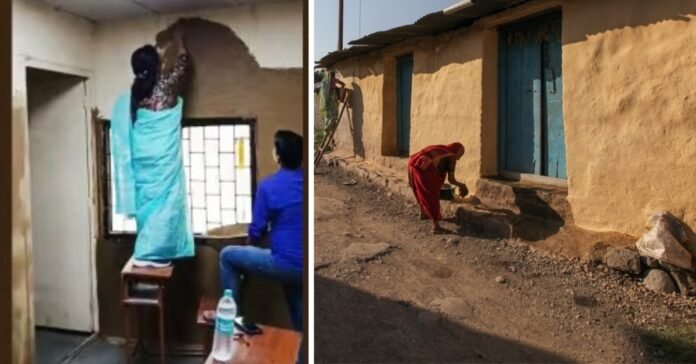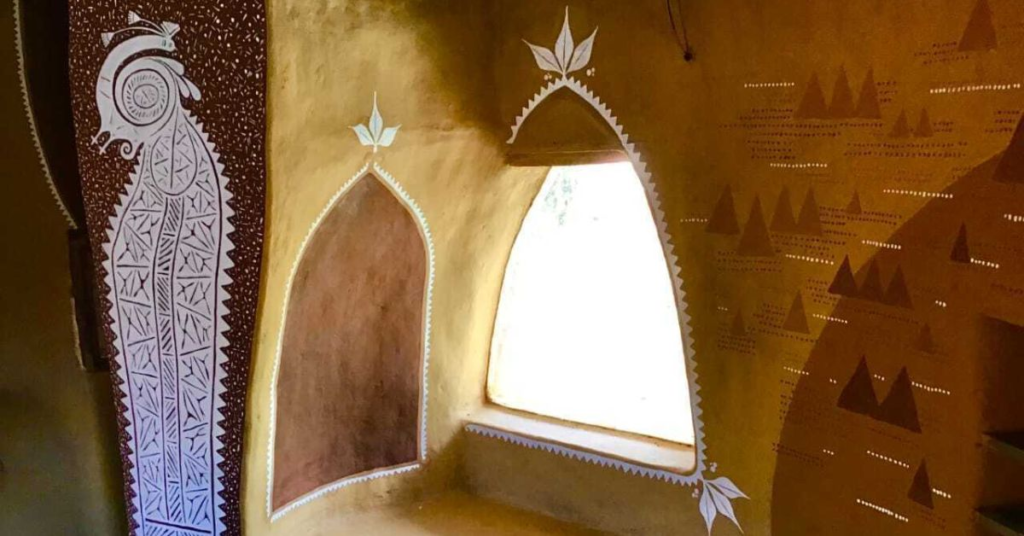
At Delhi University’s Laxmibai College, students expected a fresh coat of paint. What they didn’t expect was their principal, Dr. Pratyush Vatsala, climbing onto a chair and smoothing cow dung onto the classroom wall.
In a world obsessed with shiny surfaces and sleek finishes, it was a moment of dissonance — and, for some, disbelief. A viral video captured the scene. The internet was quick to react with a mix of shock, satire, and… curiosity.
But what looked like a quirky throwback was, in fact, a quiet revolution — one that’s digging deep into India’s traditional knowledge and offering real, earthy solutions to the climate crisis.
The Dirt on Dung: A Legacy Reborn
For generations in rural India, cow dung wasn’t waste — it was a way of life. Floors were smeared with it. Walls were plastered with it. Entire homes were built with it. It kept insects away, purified spaces, and perhaps most importantly, kept homes naturally cool in the sweltering Indian summer.
Then came cement. Concrete. Air conditioners. And with them, the slow erosion of ancient wisdom.
But now, as our cities heat up and our electricity bills skyrocket, an unlikely hero is making a comeback — with a surprising scientific edge.
A Climate-Savvy Comeback
The principal’s cow-dung-coated classroom might have raised eyebrows, but environmental pioneers across India are proving there’s method in this madness.

Enter Dr. Shivdarshan Malik, a civil engineer turned eco-innovator. Haunted by the loss of green farmland to grey concrete, Dr. Malik turned to his roots — and found answers in cow dung.
“People once dismissed it as backward,” he says. “But cow dung has properties that modern construction materials just can’t match.”
With years of research, he developed two game-changing products:
- Vedic Plaster: A breathable blend of cow dung, clay, neem leaves, gypsum, and more.
- Gocrete Bricks: Heat-reducing, eco-friendly bricks made from cow dung and local soil.
Together, they offer homes that are cooler by up to 7°C — without touching the AC remote.
The Science Behind the Slather
Cow dung is packed with perks. It:
- Acts as a natural insulator, regulating indoor temperatures.
- Has antimicrobial properties, making it a hygienic coating for homes.
- Is breathable, preventing dampness and trapped heat.
- And it’s biodegradable, renewable, and very low-cost.
In fact, homes built or renovated with Vedic Plaster have reported zero need for air conditioning. One family saved ₹8,000 a month on electricity. That’s not just eco-friendly — that’s wallet-friendly.
Building Dreams with Dirt
Across the country, eco-conscious citizens are embracing tradition with pride.

In Tamil Nadu, Sudhakar and Noushadya built a sustainable farm home using mud, lime, second-hand wood, and of course, cow dung. “We wanted to reduce our carbon footprint,” says Noushadya. “So we skipped concrete almost entirely.”

In Mumbai, Kiran Amati created a circular studio-home out of wood, straw, cow dung, and mud. It’s rustic, yes — but also cool, clean, and sustainable. His innovative waste system even uses dry leaves and sawdust instead of septic tanks.
These homes may look old-school, but their architecture is future-proof.
What Can We Learn from a Wall?
That wall at Laxmibai College? It’s more than a viral video. It’s a statement.
It reminds us that solutions to climate change don’t always come from air-conditioned labs or high-rise towers. Sometimes, they come from cow sheds, from village huts, from the hands of our grandparents.
India’s construction industry is one of the largest in the world — and one of the most energy-hungry. But with innovations like Vedic Plaster and Gocrete Bricks, we have a rare chance to blend the wisdom of the past with the needs of the present.
And maybe — just maybe — a little cow dung could help cool not just our homes, but our planet too.
Dung and Done? Not Quite.
This is just the beginning. As architects, urban planners, and homeowners look for low-cost, high-impact alternatives, cow dung could be the star of a sustainable housing movement.
What we once wiped away, we now need to embrace.
After all, in the race to survive climate change, every degree cooler — and every idea rooted in the earth — counts.

